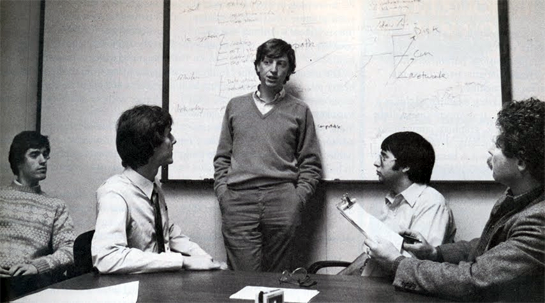 What’s the most efficient way to deride a technology product as a stinker and/or a flop? Easy: Compare it to Microsoft Bob. Bring up the infamous Windows 3.1 front-end for computing newbies–officially released fifteen years ago this week, on March 31st, 1995–and you need say no more. Everything from OS X to Twitter to Google Wave to (inevitably) Windows Vista has gotten the treatment.
What’s the most efficient way to deride a technology product as a stinker and/or a flop? Easy: Compare it to Microsoft Bob. Bring up the infamous Windows 3.1 front-end for computing newbies–officially released fifteen years ago this week, on March 31st, 1995–and you need say no more. Everything from OS X to Twitter to Google Wave to (inevitably) Windows Vista has gotten the treatment.
Bob’s pervasiveness as an insult long ago transcended its brief period of prominence as a product. By now, it’s unlikely that the vast majority of people who use it as shorthand for “embarrassing tech failure” ever actually used it–any more than the average person who cracks jokes about the Ford Edsel has spent time behind the wheel of one.
But Bob didn’t start out as one of technology’s most reliable laugh lines. It may strain credulity given Bob’s current reputation, but back in 1995, even pundits who had their doubts about the software seemed to accept the idea that it was a sneak preview of where user interfaces were going. And even though Bob died just one year later, Microsoft continued to Bob-ize major applications for years–most notably every version of Office from Office 97 through Office 2003, all of which featured the notorious Office Assistant helper, better known as Clippy.
In its own odd way, Bob is ripe for rediscovery. Hence our fifteenth-anniversary celebration, which includes the story you’re reading; a guided tour of Bob in slideshow form; and memories of Bob and its offspring from Tandy Trower, who worked at Microsoft for 28 years. Whether you’re appalled by Bob, defiantly enchanted by Bob, or never knew Bob at all, read on–and let us know what you think.
(Thanks to Dan Rose, Rogers Cadenhead, and David Worthington for their help with our Bobfest.)
Continue Reading →
 When Microsoft Bob officially hit store shelves on March 31st, 1995, it wasn’t synonymous with “tech-product flop of monumental proportions.” Even pundits who weren’t so sure about it tended to buy into the notion that it was a sneak peek at where interfaces were going. And almost nobody would have guessed that Microsoft would kill it a year later.
When Microsoft Bob officially hit store shelves on March 31st, 1995, it wasn’t synonymous with “tech-product flop of monumental proportions.” Even pundits who weren’t so sure about it tended to buy into the notion that it was a sneak peek at where interfaces were going. And almost nobody would have guessed that Microsoft would kill it a year later.
 What’s the most efficient way to deride a technology product as a stinker and/or a flop? Easy: Compare it to Microsoft Bob. Bring up the infamous Windows 3.1 front-end for computing newbies–officially released fifteen years ago this week, on March 31st, 1995–and you need say no more. Everything from
What’s the most efficient way to deride a technology product as a stinker and/or a flop? Easy: Compare it to Microsoft Bob. Bring up the infamous Windows 3.1 front-end for computing newbies–officially released fifteen years ago this week, on March 31st, 1995–and you need say no more. Everything from  After I managed the
After I managed the  Remember the nifty tech-company reference in Robert Zemeckis’s 1994 blockbuster
Remember the nifty tech-company reference in Robert Zemeckis’s 1994 blockbuster 
 Yesterday I paid a long-overdue visit to one of the Bay Area’s most amazing geek destinations–the Weird Stuff Warehouse, which salvages the hardware and software that Silicon Valley has lost interest in. The place has been in business for a quarter century and throngs of shoppers were roaming the aisles during my expedition. And it was bursting at the seams with shrinkwrapped software for defunct platforms, obsolete gadgets, components and cables of every imaginable type, and much, much more.
Yesterday I paid a long-overdue visit to one of the Bay Area’s most amazing geek destinations–the Weird Stuff Warehouse, which salvages the hardware and software that Silicon Valley has lost interest in. The place has been in business for a quarter century and throngs of shoppers were roaming the aisles during my expedition. And it was bursting at the seams with shrinkwrapped software for defunct platforms, obsolete gadgets, components and cables of every imaginable type, and much, much more. to admit this, but I’ve lived in the Bay Area for almost eight years without paying a single visit to one of its most legendary temples, Sunnyvale’s
to admit this, but I’ve lived in the Bay Area for almost eight years without paying a single visit to one of its most legendary temples, Sunnyvale’s  You saved and you saved until you could finally buy that shiny new $1000 gadget that promised you everything under the stars. When it came time to plug it in, you found your joy being subsumed by abject horror. Your stomach plunged deep into your gut and you (yes, mortal non-designer you) recognized a fundamental flaw in your flashy gizmo so obvious that it made you want to pick up the device and smash it over the designer’s head.
You saved and you saved until you could finally buy that shiny new $1000 gadget that promised you everything under the stars. When it came time to plug it in, you found your joy being subsumed by abject horror. Your stomach plunged deep into your gut and you (yes, mortal non-designer you) recognized a fundamental flaw in your flashy gizmo so obvious that it made you want to pick up the device and smash it over the designer’s head. I spent a couple of my formative years as a tech journalist working at
I spent a couple of my formative years as a tech journalist working at  Back in the 1980s, if you wanted to stay particularly up-to-date on the PC business, you read a newsweekly–and there was a high chance that the newsweekly you read was IDG’s InfoWorld. Among the most venerable and successful computing publications–it started in 1978 and
Back in the 1980s, if you wanted to stay particularly up-to-date on the PC business, you read a newsweekly–and there was a high chance that the newsweekly you read was IDG’s InfoWorld. Among the most venerable and successful computing publications–it started in 1978 and